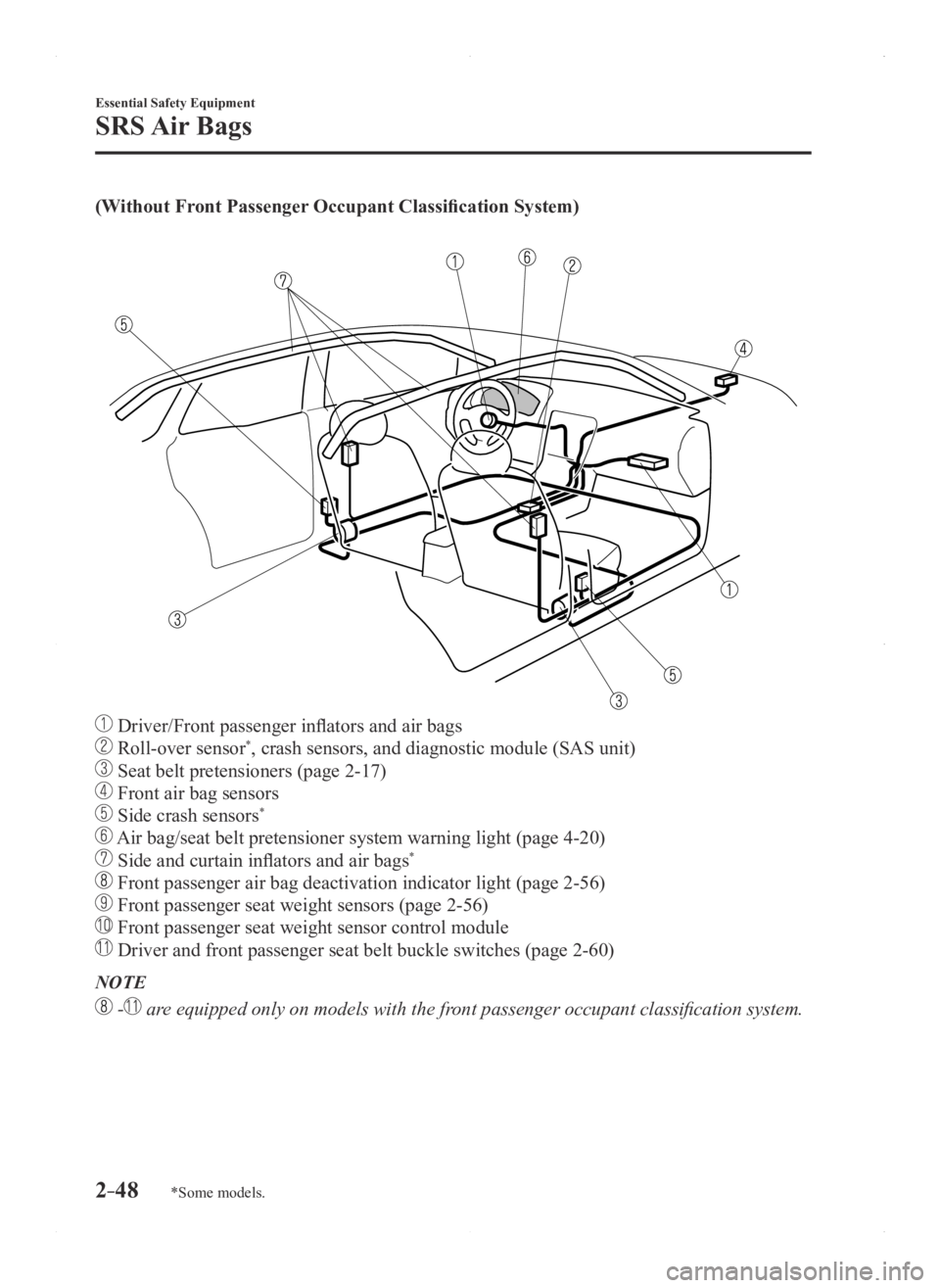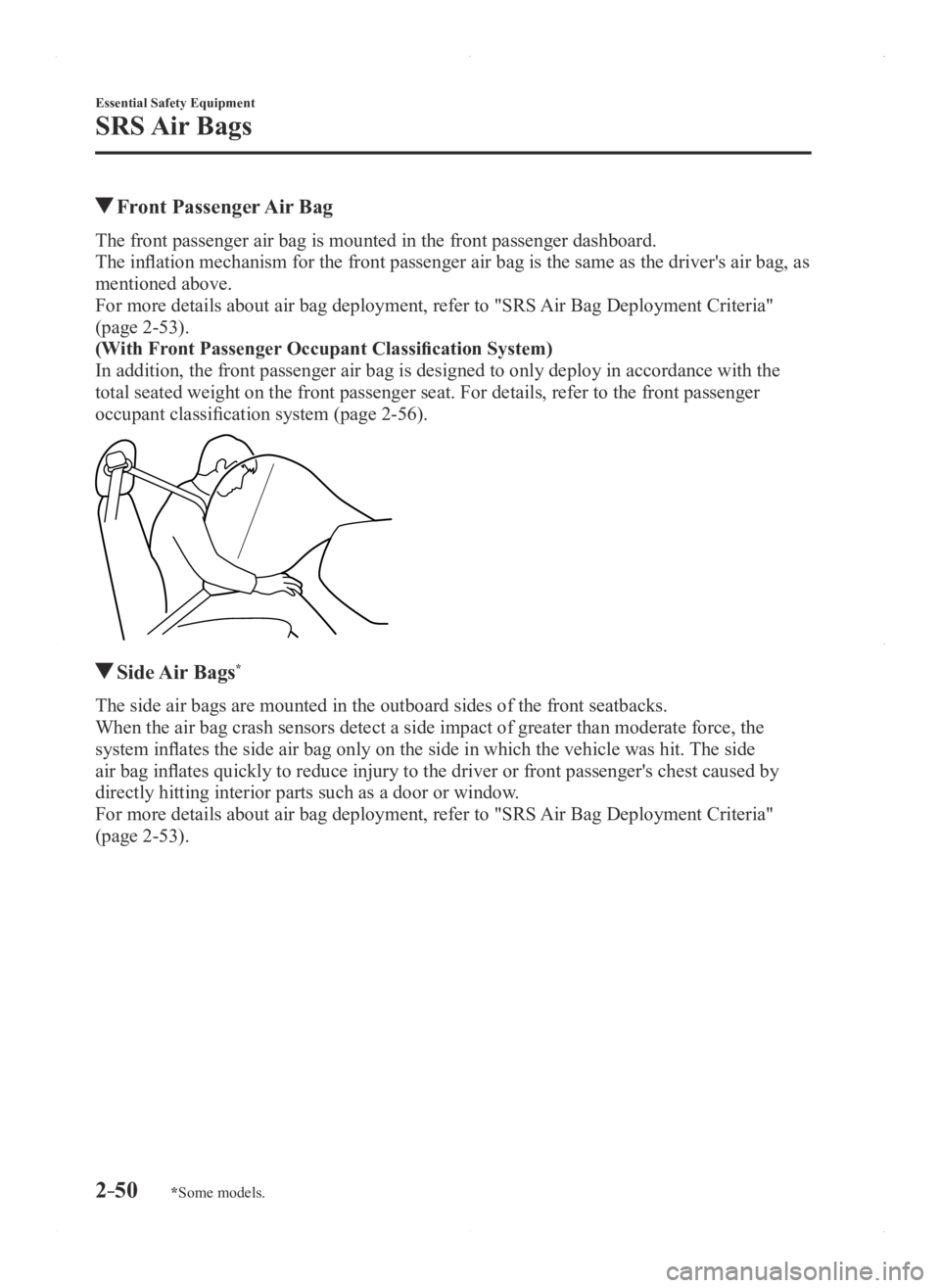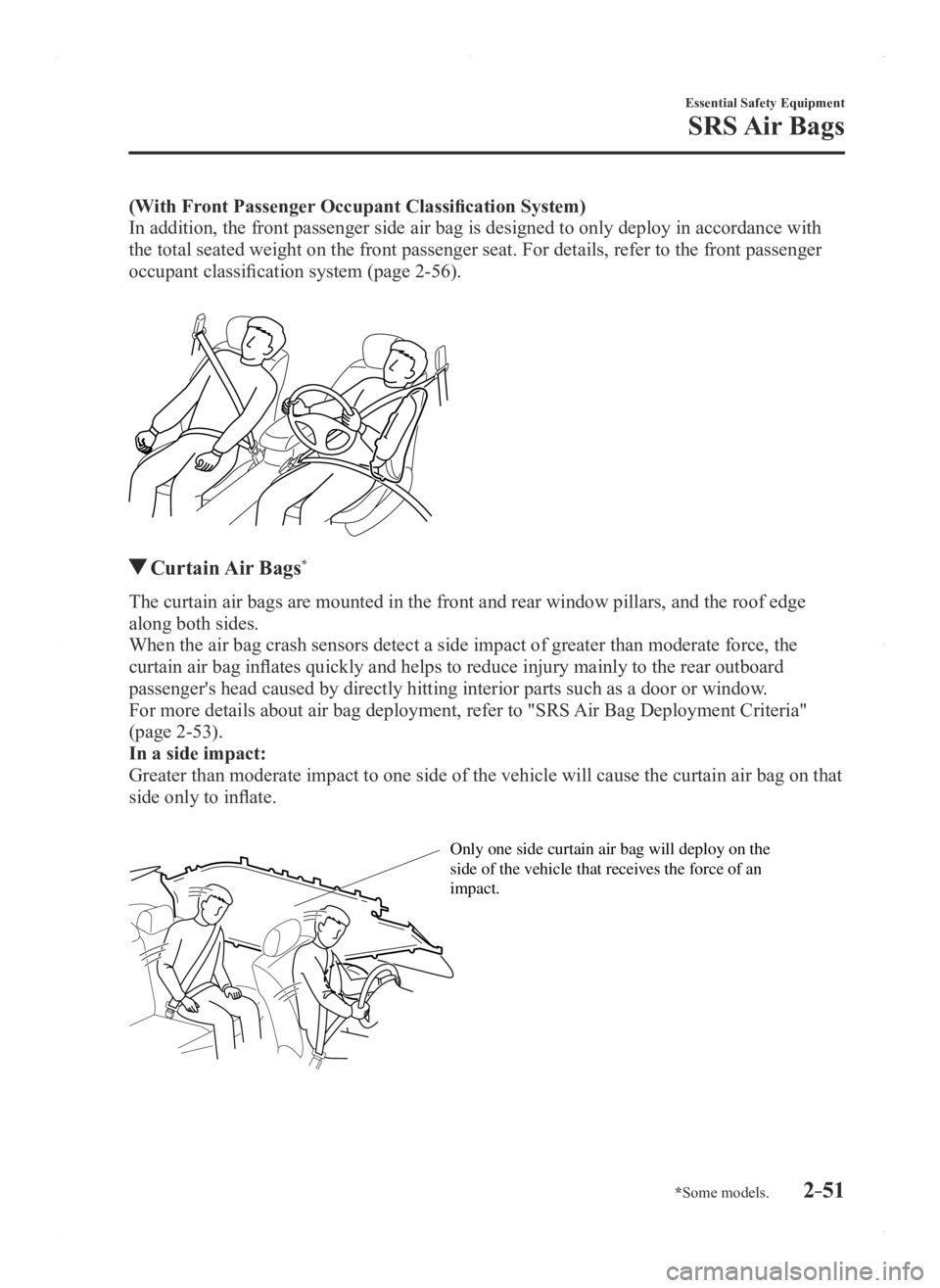MAZDA MODEL 3 5-DOOR 2016 Repair Manual
Manufacturer: MAZDA, Model Year: 2016, Model line: MODEL 3 5-DOOR, Model: MAZDA MODEL 3 5-DOOR 2016Pages: 598, PDF Size: 30.13 MB
Page 61 of 598

2–47
Essential Safety Equipment
SRS Air Bags
Supplemental Restraint System Components
(With Front Passenger Occupant Classification System)
Mazda3_8FA4-EA-15G_Edition1.indb 472015/05/11 14:00:12
Page 62 of 598

2–48
Essential Safety Equipment
SRS Air Bags
*Some models.
(Without Front Passenger Occupant Classification System)
Driver/Front passenger inflators and air bags
Roll-over sensor*, crash sensors, and diagnostic module (SAS unit)
Seat belt pretensioners (page 2-17)
Front air bag sensors
Side crash sensors*
Air bag/seat belt pretensioner system warning light (page 4-20)
Side and curtain inflators and air bags*
Front passenger air bag deactivation indicator light (page 2-56)
Front passenger seat weight sensors (page 2-56)
Front passenger seat weight sensor control module
Driver and front passenger seat belt buckle switches (page 2-60)
NOTE
- are equipped only on models with the front passenger occupant classification system.
Mazda3_8FA4-EA-15G_Edition1.indb 482015/05/11 14:00:12
Page 63 of 598

2–49
Essential Safety Equipment
SRS Air Bags
How the SRS Air Bags Work
Your Mazda is equipped with the following types of SRS air bags. SRS air bags are
designed to work together with the seat belts to help to reduce injuries\
during an accident.
The SRS air bags are designed to provide further protection for passengers in addition to the
seat belt functions. Be sure to wear seat belts properly.
Front Seat Belt Pretensioners
The front seat belt pretensioners are designed to deploy in moderate or \
severe frontal, near
frontal collisions.
In addition, the pretensioners operate when a side collision (only on t\
he side in which the
collision occurs) or a roll-over accident is detected. The pretensioners operate differently
depending on what types of air bags are equipped. For details on the seat belt pretensioner
operation, refer to the SRS Air Bag Deployment Criteria (page 2-53).
Driver Air Bag
The driver's air bag is mounted in the steering wheel.
When air bag crash sensors detect a frontal impact of greater than moder\
ate force, the
driver's air bag inflates quickly helping to reduce injury mainly to the driver's head or chest
caused by directly hitting the steering wheel.
For more details about air bag deployment, refer to "SRS Air Bag Deployment Criteria"
(page 2-53).
(With Front Passenger Occupant Classification System)
The driver's dual-stage air bag controls air bag inflation in two energy stages. During an
impact of moderate severity, the driver's air bag deploys with lesser energy, whereas during
more severe impacts, it deploys with more energy.
Mazda3_8FA4-EA-15G_Edition1.indb 492015/05/11 14:00:13
Page 64 of 598

2–50
Essential Safety Equipment
SRS Air Bags
*Some models.
Front Passenger Air Bag
The front passenger air bag is mounted in the front passenger dashboard.\
The inflation mechanism for the front passenger air bag is the same as the driver's air bag, as
mentioned above.
For more details about air bag deployment, refer to "SRS Air Bag Deployment Criteria"
(page 2-53).
(With Front Passenger Occupant Classification System)
In addition, the front passenger air bag is designed to only deploy in a\
ccordance with the
total seated weight on the front passenger seat. For details, refer to t\
he front passenger
occupant classification system (page 2-56).
Side Air Bags*
The side air bags are mounted in the outboard sides of the front seatbac\
ks.
When the air bag crash sensors detect a side impact of greater than mode\
rate force, the
system inflates the side air bag only on the side in which the vehicle was hit. The side
air bag inflates quickly to reduce injury to the driver or front passenger's chest caused by
directly hitting interior parts such as a door or window.
For more details about air bag deployment, refer to "SRS Air Bag Deployment Criteria"
(page 2-53).
Mazda3_8FA4-EA-15G_Edition1.indb 502015/05/11 14:00:13
Page 65 of 598

2–51
Essential Safety Equipment
SRS Air Bags
*Some models.
(With Front Passenger Occupant Classification System)
In addition, the front passenger side air bag is designed to only deploy\
in accordance with
the total seated weight on the front passenger seat. For details, refer \
to the front passenger
occupant classification system (page 2-56).
Curtain Air Bags*
The curtain air bags are mounted in the front and rear window pillars, a\
nd the roof edge
along both sides.
When the air bag crash sensors detect a side impact of greater than mode\
rate force, the
curtain air bag inflates quickly and helps to reduce injury mainly to the rear outboard
passenger's head caused by directly hitting interior parts such as a doo\
r or window.
For more details about air bag deployment, refer to "SRS Air Bag Deployment Criteria"
(page 2-53).
In a side impact:
Greater than moderate impact to one side of the vehicle will cause the curtain air bag on that
side only to inflate.
Only one side curtain air bag will deploy on the
side of the vehicle that receives the force of an
impact.
Mazda3_8FA4-EA-15G_Edition1.indb 512015/05/11 14:00:13
Page 66 of 598

2–52
Essential Safety Equipment
SRS Air Bags
(With Front Passenger Occupant Classification System)
In a roll-over:
In response to a vehicle roll-over, both curtain air bags inflate.
Both curtain air bags will deploy after the roll-over accident is detected.
(With Front Passenger Occupant Classification System)
In an angled collision:
During a collision, the driver and front passenger's air bags will deplo\
y. Depending on the
nature of the impact, the side air bag and the curtain air bag may deplo\
y.
Warning Light/Beep
A system malfunction or operation conditions are indicated by a warning.
Refer to Warning/Indicator Lights on page 4-20.
Refer to Warning Sound is Activated on page 7-35.
Mazda3_8FA4-EA-15G_Edition1.indb 522015/05/11 14:00:14
Page 67 of 598

2–53
Essential Safety Equipment
SRS Air Bags
*Some models.
SRS Air Bag Deployment Criteria
This chart indicates the applicable SRS equipment that will deploy depending on the type of
collision.
(The illustrations are the representative cases of collisions.)
SRS
equipment Types of collision
A severe frontal/near frontal collision A severe side
collision
*4A roll-over/near roll-over*3A rear collision
Front seat belt
pretensioner X*1 (both sides)
X*1 (impact side
only) X*1 (both sides)
No air bag and
front seat belt
pretensioner will be
activated in a rear
collision.
Driver air
bag X
Front
passenger air bag X
*1
Side air bag*X*2X*1 (impact side
only)
Curtain air bag
*X*2X (impact side only) X (both sides)
X: The SRS air bag equipment is designed to deploy in a collision.
*1 (With Front Passenger Occupant Classification System) The front passenger front and side air bags and the seat belt pretension\
er are designed to deploy depending on the condition of the total seated weight on the front passenger seat.*2 (With Front Passenger Occupant Classification System) In an angled collision, the side air bag and curtain air bag may deploy .*3 (With Front Passenger Occupant Classification System) In a roll-over accident, the seat belt pretensioners and the curtain air\
bags deploy .*4 (With Side/Curtain Air Bags) In a side collision, the seat belt pretensioners and the side/curtain ai\
r bags deploy (only on the side in which the collision occurs).
Mazda3_8FA4-EA-15G_Edition1.indb 532015/05/11 14:00:15
Page 68 of 598

2–54
Essential Safety Equipment
SRS Air Bags
Limitations to SRS Air Bag
In severe collisions such as those described previously in "SRS Air Bag Deployment
Criteria", the applicable SRS air bag equipment will deploy. However, in some accidents,
the equipment may not deploy depending on the type of collision and its severity.
Limitations to front/near front collision detection:
The following illustrations are examples of front/near front collisions \
that may not be
detected as severe enough to deploy the SRS air bag equipment.
Impacts involving trees or polesFrontal offset impact to the vehicle
Rear-ending or running under a truck's tail gate
Mazda3_8FA4-EA-15G_Edition1.indb 542015/05/11 14:00:15
Page 69 of 598

2–55
Essential Safety Equipment
SRS Air Bags
Limitations to side collision detection:
The following illustrations are examples of side collisions that may not\
be detected as severe
enough to deploy the SRS air bag equipment.
Side impacts involving trees or polesSide impacts with two-wheeled vehicles
Roll-over (Without Front Passenger Occupant Classification System)
(With Front Passenger Occupant Classification System)
Limitations to roll-over detection:
The following illustration is an example of an accident that may not be \
detected as a roll-
over accident. Therefore, the front seat belt pretensioners and curtain air bags may no\
t
deploy.
Pitch end over end
Mazda3_8FA4-EA-15G_Edition1.indb 552015/05/11 14:00:16
Page 70 of 598

2–56
Essential Safety Equipment
SRS Air Bags
*Some models.
Front Passenger Occupant Classification System*
First, please read "Supplemental Restraint System (SRS) Precautions" (page 2-40)
carefully.
Front Passenger Seat Weight Sensor
Your vehicle is equipped with a front passenger seat weight sensors as a part of the
supplemental restraint system. These sensors are located under both of the front passenger
seat rails. These sensors determine the total seated weight on the front passenger s\
eat and
monitor the seat belt buckle for the front passenger seat. The SAS unit is designed to prevent
the front passenger front and side air bags and seat belt pretensioner s\
ystem from deploying
if the front passenger air bag deactivation indicator light illuminates.\
To reduce the chance of injuries caused by deployment of the front passen\
ger air bag,
the system deactivates the front passenger front and side air bags and a\
lso the seat
belt pretensioner system when the front passenger air bag deactivation i\
ndicator light
illuminates. Refer to the following table for the front passenger air bag deactivation
indicator light illumination conditions.
This system shuts off the front passenger front and side air bags and seat belt pretensioner\
system, so make sure the front passenger air bag deactivation indicator \
light illuminates
according to the following table.
The air bag/front seat belt pretensioner system warning light flashes and the front passenger
air bag deactivation indicator light illuminates if the sensors have a p\
ossible malfunction.
If this happens, the front passenger front and side air bags and seat be\
lt pretensioner system
will not deploy.
Front passenger air bag deactivation indicator light
This indicator light illuminates to remind you that the front passenger \
front and side air bags
and seat belt pretensioner will not deploy during a collision.
If the front passenger weight sensors are normal, the indicator light il\
luminates when the
ignition is switched ON. The light turns off after a few seconds. Then, the indicator light
illuminates or is off under the following conditions:
Mazda3_8FA4-EA-15G_Edition1.indb 562015/05/11 14:00:16